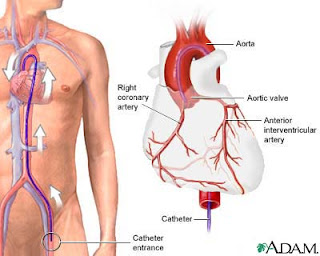Angiography Notes
This is a technique used to visualise the inside of vessels, in this case, those of the heart.
It is basically used to assess the extent of angina. It involves cardiac catheterisation. Once the catheter is in place, an iodine based dye is injected into the coronary vessels, and the extent of narrowing (atheroma) can be asses by –xray.
- The angiogram is actually recorded as a moving picture as many low-dose x-rays are taken in quick succession.
Procedure
- The patient will lie flat on a couch, with the x-ray machine above them. The catheter will be passed to the opening of the cardiac vessels from the aorta.
o Patients may feel an occasional missed or extra heart beat during the procedure – this is normal.
- Basically – its exactly the same as catheterisation! – except that a bit of dye is quirted in and x-rays taken.
- The test normally lasts about 30 minutes.
Complications
- Mortality is about 1%
- May be some bruising at the entry site
- Some patients may have stitches at the entry site to seal it up
- May have a false aneurysm at the femoral artery if this was used as the entry site
- May get angina-type pain during the procedure
- May get an infection at the site of entry
- May have a warm flushing feeling when the dye is injected
- Stroke and MI are possible but rare
- Also rarely, the coronary artery may be damaged and emergency bypass may need to be performed
Notes by Tom Leach

EmoticonEmoticon